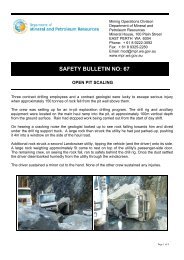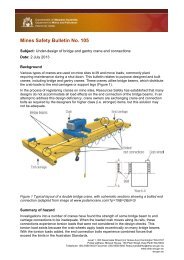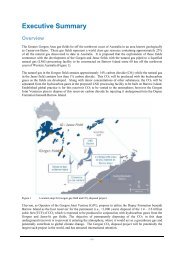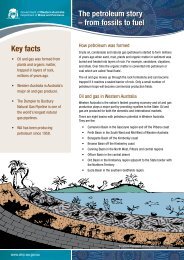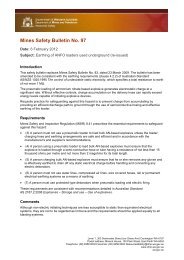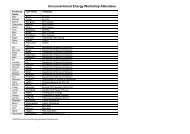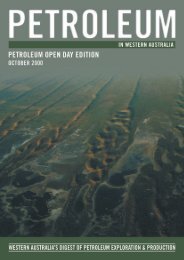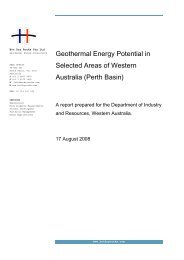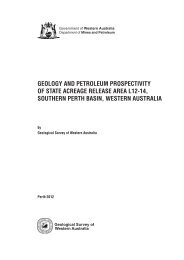IN WESTERN AUSTRALIA - Department of Mines and Petroleum
IN WESTERN AUSTRALIA - Department of Mines and Petroleum
IN WESTERN AUSTRALIA - Department of Mines and Petroleum
Create successful ePaper yourself
Turn your PDF publications into a flip-book with our unique Google optimized e-Paper software.
y introducing appropriate organisms into suitable<br />
coals. This process <strong>of</strong> in-situ biogasification is at the<br />
conceptual stage at present, but has important longterm<br />
implications. Further refinement <strong>of</strong> this process<br />
may be provided by the use <strong>of</strong> genetic engineering<br />
to optimise the organisms for gas generation.<br />
There is some difference <strong>of</strong> opinion regarding the<br />
nature <strong>of</strong> biogenically generated gas in coal seams<br />
- some authorities consider that there is little, if any,<br />
adsorbed gas, <strong>and</strong> that the gas is present in a ‘free’<br />
form in the cleats (small fractures in the coal) <strong>and</strong><br />
other openings, as well as in formation waters. It is<br />
probable that both biogenic <strong>and</strong> thermogenic<br />
scenarios embrace adsorbed, ‘free’ <strong>and</strong> dissolved<br />
gas, but in different proportions. In both scenarios,<br />
the retention <strong>of</strong> gas is almost totally dependant<br />
upon hydrostatic pressure <strong>and</strong> commercial<br />
production, thus involving the production <strong>of</strong><br />
significant water to lower the hydrostatic pressure to<br />
permit the gas to flow.<br />
Coal quality<br />
Increasing ash content causes coal strength to<br />
increase, thereby decreasing the potential for<br />
fracturing/cleating. Coals with lesser amounts <strong>of</strong> ash<br />
are, therefore, the most likely to have the greatest<br />
cleat development - <strong>and</strong> thus the highest<br />
permeabilities. Also, as the ash component <strong>of</strong> coal<br />
cannot absorb methane, it reduces the volume <strong>of</strong><br />
gas that can be contained in a unit volume <strong>of</strong> coal.<br />
The maximum ash content before a coal becomes<br />
non-commercial has not been determined, but<br />
probably varies according to other parameters such<br />
as maturation level. Additionally, the cleat density is<br />
greater in the brighter coal types - such as vitrain<br />
<strong>and</strong> bright clarain <strong>and</strong> substantially less in the dull<br />
coals - like durain.<br />
The process <strong>of</strong> gas flow from the solid coal to the<br />
cleats is one <strong>of</strong> diffusion. Usually the cleats are filled<br />
with water <strong>and</strong> the desorption <strong>of</strong> gas within the cleats<br />
leads to the two phases existing within the cleats. If a<br />
secondary major fracture system exists, flow may<br />
then take place from the cleats to the major fractures<br />
(Figure 1). Both the cleats <strong>and</strong> major fractures exhibit<br />
their own phase dependant permeabilities.<br />
Diagenesis may cause deposition <strong>of</strong> mineral matter<br />
in the coal cleats, significantly reducing coal<br />
permeability. Carbonate infilling is the most<br />
common form <strong>of</strong> diagenesis in coals, but silica,<br />
pyrite, illite, smectite, kaolinite <strong>and</strong> other clays have<br />
also been observed as cleat infillings. Prospective<br />
gas coals should thus be relatively free <strong>of</strong> such<br />
cleat-filling substances.<br />
The gas content <strong>of</strong> any prospective coal should be<br />
greater than 8.5 cc/g (300 scf/t). The coals also<br />
need to reach a certain level <strong>of</strong> thermal maturity in<br />
order to generate gas <strong>and</strong> to produce the structure<br />
<strong>and</strong> chemistry necessary for storing commercial<br />
quantities <strong>of</strong> methane within the coal. The vitrinite<br />
reflectance should be in the range <strong>of</strong> R O <strong>of</strong> 0.7% to<br />
R O <strong>of</strong> 2.0%. In general, the higher the maturity, the<br />
greater the adsorption capability <strong>of</strong> any coal. From<br />
looking at coal seam methane operations in the US,<br />
where the industry is approaching a mature stage, it<br />
appears that the minimum thickness <strong>of</strong> coal<br />
required to produce commercial quantities <strong>of</strong> gas is<br />
5 to 6 metres in no more than 3 or 4 seams.<br />
The gas content <strong>of</strong> coal is usually determined by<br />
gas desorption procedures, which means gas is<br />
desorbed from coal by placing a sample <strong>of</strong> the coal<br />
(usually from drillcore) in a sealed container, <strong>and</strong><br />
measuring the amount <strong>of</strong> released gas over periods<br />
which may range from days to months. This<br />
procedure requires the gas to be desorbed from the<br />
coal’s micropore structure (ie the thermogenic<br />
scenario); however, the predominantly ‘free’ gas <strong>of</strong><br />
the biogenic scenario (or a significant component <strong>of</strong><br />
it) may not be detected by this desorption method<br />
<strong>and</strong>, hence, the resulting low to non-existent gas<br />
contents may give a quite false portrayal <strong>of</strong> gas<br />
producibility from a formation.<br />
Pressure <strong>and</strong> permeability<br />
In thermogenic situations, gas is adsorbed onto the<br />
coal’s micropore surfaces <strong>and</strong> held in place by the<br />
reservoir (water) pressure. The methane within a<br />
coal seam is released when the hydrostatic<br />
pressure is reduced, allowing the cleats in the coal<br />
to exp<strong>and</strong>, increasing permeability <strong>and</strong> commencing<br />
the process <strong>of</strong> desorption <strong>of</strong> the methane gas from<br />
the coal. Most coals show a significant relationship<br />
between effective stress (total stress minus<br />
hydrostatic pressure) <strong>and</strong> permeability. The cleats<br />
being closed by increasing effective stress cause a<br />
reduction in permeability. If fluid pressure is high, it<br />
tends to open the cleats <strong>and</strong> as pressure decreases<br />
with fluid withdrawal the cleats close. The reduction<br />
in permeability may be <strong>of</strong> an order <strong>of</strong> magnitude for<br />
anything between 2 <strong>and</strong> 10 MPa <strong>of</strong> increasing<br />
effective stress. The s<strong>of</strong>ter the coal the more<br />
pronounced this effect is.<br />
As water <strong>and</strong> gas are produced from the seam, the<br />
effective stress increases leading generally to a<br />
reduction in permeability. Many coals, however,<br />
exhibit an increase in permeability with production.<br />
Figure 1. Flow through cleats in coal<br />
PWA April Edition - Coal Seam Methane 35<br />
This is caused by an effect that tends to de-stress<br />
the seam. This de-stressing is a result <strong>of</strong> the fact<br />
that most coals shrink as gas is desorbed. The<br />
shrinkage reduces the lateral stress on the seam<br />
<strong>and</strong> shifts that stress into the surrounding rocks.<br />
These two opposing effects on the effective stress<br />
mean that the permeability <strong>of</strong> the seam may either<br />
decrease or increase with the removal <strong>of</strong> gas <strong>and</strong><br />
water from the seam, depending on the<br />
characteristics <strong>of</strong> the coal <strong>and</strong> associated gas.<br />
Frequently both these effects are present, with an<br />
initial permeability decrease in the reservoir<br />
pressure around the producing well, followed by an<br />
increase as significant desorption-induced<br />
shrinkage occurs within the coal.<br />
Depending on the nature <strong>of</strong> the coal <strong>and</strong> depth <strong>of</strong><br />
burial, this release <strong>of</strong> methane varies from negligible<br />
gas flow to commercial rates <strong>of</strong> gas flow, although<br />
in all cases a significant amount <strong>of</strong> time is required<br />
to dewater the coal bed before any gas is<br />
recovered. Timing <strong>of</strong> water h<strong>and</strong>ling is one <strong>of</strong> the<br />
major differences between CSM <strong>and</strong> convention<br />
gas. With conventional gas, gas is trapped under<br />
pressure <strong>and</strong> overlies water. This pressure is then<br />
used to allow the gas to flow to surface through the<br />
well casing until the rising water level in the trap<br />
increases to the point where the amount <strong>of</strong> gas<br />
produced relative to water becomes uneconomic<br />
because the rate <strong>of</strong> gas production is so low. In<br />
CSM operations, the water, which is holding the gas<br />
to the coal through hydrostatic pressure, is drained<br />
first <strong>and</strong> as the water pressure (measured in terms<br />
<strong>of</strong> hydrostatic pressure on the gasfield) decreases,<br />
adsorbed gas is released from the coal seam <strong>and</strong><br />
then produced through the well bore over a long<br />
period (Figure 2). Over time, the rate <strong>of</strong> gas<br />
desorption decreases until the flow rates become<br />
uneconomic to continue to produce from the bore.<br />
The water, which is commonly saline but in some<br />
areas can be potable, must be disposed <strong>of</strong> in an<br />
environmentally acceptable manner. Surface<br />
disposal <strong>of</strong> large volumes <strong>of</strong> potable water can<br />
affect streams <strong>and</strong> other habitats, <strong>and</strong> subsurface<br />
reinjection makes production more costly.




